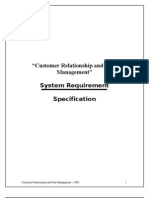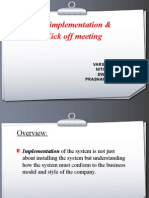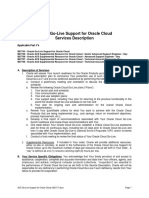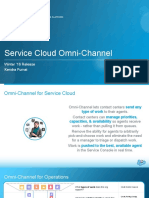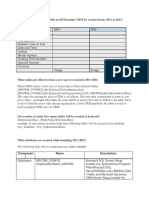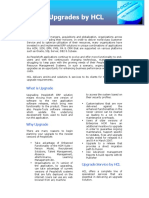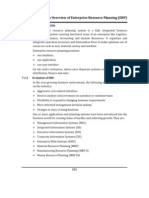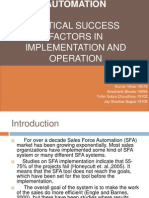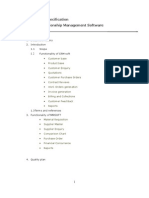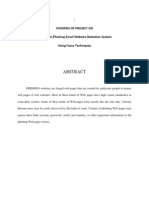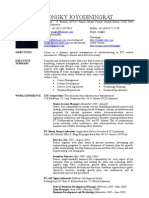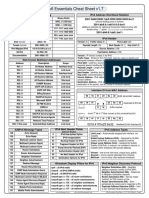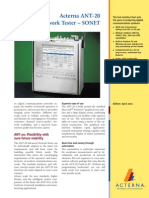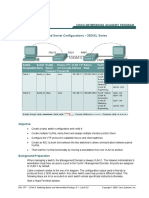CRM Technical Requirements
CRM Technical Requirements
Uploaded by
Mehedul Islam SabujCopyright:
Available Formats
CRM Technical Requirements
CRM Technical Requirements
Uploaded by
Mehedul Islam SabujOriginal Description:
Copyright
Available Formats
Share this document
Did you find this document useful?
Is this content inappropriate?
Copyright:
Available Formats
CRM Technical Requirements
CRM Technical Requirements
Uploaded by
Mehedul Islam SabujCopyright:
Available Formats
CRM Technical Requirements
Robust Server Infrastructure and Expandable Architecture
o
For on-premise solutions, specify the server hardware accurately; otherwise you'll incur costly reconfiguration and downtime. Consider the architecture so the system can grow as the business becomes more reliant on the new process. Ensure you have adequate built-in disaster recovery features, including hot standby servers, robust backup policies and fault tolerance within the storage and key architecture components.
Cleansing Software for Data During Migration
o
When you prepare data on prospects, customers and contacts for the new database, use address-matching and cleansing software to cleanse, deduplicate and transform the data. Scribe Insight and SQL Business Intelligence Development Studio reduce the programming effort required to achieve this. Sponsored Links Download Free .NET CMS Easy to Use, Flexible, SEO friendly Lifetime Free, Even for Commerce. Kentico.com/Free-Edition
Web Server and Client Technologies
o
Use Web technologies to provide the application programming interface, or API. Web services and SOAP messages and responses query the APIs. Because field sales personnel often need to capture data out of the office, Web technologies are ideal because they are bandwidth-efficient.
Database Administration, Security and Tuning
o
CRM systems store their information on relational databases such as Oracle and Microsoft SQL Server. For on-premise deployments, you must effectively manage the large quantity of information captured. Optimize the database so delivery of information to the client computer is speedefficient, and back up data. Employ adequate disaster recovery procedures to protect valuable business data.
Effective Integration
Object-oriented programming effectively integrates systems. Application programming interfaces exist for your email client (Outlook or Lotus Notes); list server for email campaigns; order-taking system; financial reporting system; phone system, and mobile devices. Many are available as add-ins and extensions that can be adapted at a cost, which is preferable. Microsoft C# (Oracle's Siebel CRM, Microsoft Dynamics CRM), Java (Sun Microsystems) and APEX (Salesforce hosted CRM) are common languages used by leading providers of CRM.
Well-Built User Interface
o
The user interface must be adapted to capture only relevant business information. User adoption of any CRM system is more or less proportional to how simple it is to search, update and link to information. Use specialist programmers who understand your processes to create simple-to-use, efficient interfaces.
Refined Process Automation (Work Flows)
o
Continually adapt your strategy for automating and standardizing sales processes. The business logic needs to be built in to control event flow and information storage. If you can't easily change your business logic and process automation, you are not leveraging the full power of CRM. Workflow builders or script-based languages such as APEX create process automation within both types of deployment.
Electronic Report Writing and Data Mining
o
SQL Reporting Services, SAP Crystal Reports and Oracle Business Intelligence Publisher enable creation of analytical, operational and management reports and dashboards. Strategic decisions emerge from the reporting of information stored in the CRM system and others integrated with it. Resulting data are stored in a data warehouse solution such as Microsoft SQL Analysis Services, Sybase or QlikView.
Functional Requirements for CRM
1. Server Machine
o
A CRM application collaborates all employee comments and entries into the system, so the system needs a centralized host. The centralized host can host the executable files, or users can run the application from the machine. If the CRM runs from the user's machine, then the application must connect to a local server. Each customer record, entry and interaction with the application sends requests to the main server. The server machine
needs exceptional storage space, memory and a high-powered processor to process requests from several different computers on the network.
Database
o
A database contains all the records created and edited in the CRM software. The administrator can install the database engine on the server that hosts the CRM central application or on a separate server. A database can hold millions of records, so it also needs exceptional storage capacity, processor speed, memory and network connectivity. CRM software supports different database platforms including Oracle, SQL Server and MySQL. Each of these databases support enterprise applications including CRM storage.
Networking
o
Since a CRM tool provides collaboration for customer records, a company network is also required. Each client computer that needs access to the CRM tool needs network configurations including a network interface card (NIC). The client computers are connected to a hub or router that directs communication packets directly to the CRM server and database engine. The chosen CRM solution determines the type of network platform. CRM applications support Novell, Windows, Apple and Linux network architectures.
2 2.1 2.1.1 2.1.2. 2.1.3 2.1.4 2.1.5 2.2. 2.2.1 2.2.2 2.3 2.3.1 2.3.2 2.4 2.4.1 2.4.2 2.4.3
Technical Requirements Technical platform Compatible hardware Compatible OS Compatible database Compatible web server Thin or thick client Scalability User load and distribution 3-tier architecture Availability High-availability features Backup and recovery requirements Integration Required integrations Standard API Fully exposed data model
2.5 2.5.1 2.5.2 2.5.3
Development environment Customization depth required/power of customization tool Standard script/programming language Support for migrating customizations to production
3 Functional Requirements 3.1 Cross-functional requirements 3.1.1 Phone integration 3.1.1.1 Screen pops 3.1.1.2 Entitlement checking 3.1.1.3 Outbound dialing 3.1.1.4 Support of specific phone switch 3.1.2 Email support 3.1.2.1 Email integration Link to corporate email system Tag outbound emails Bulk outbound emails Automatic load of incoming email Automatic processing of incoming emails Firewall compatibility requirements 3.1.2.2 Email processing Automatic acknowledgements on emails Routing of incoming emails Canned response templates Automatic response suggestions Automatic responses 3.1.2.3 Email utilities Spell checking Supported formats Email templates Attachments (inbound/outbound) 3.1.3 Customer Portal 3.1.3.1 Knowledge base KB access from portal Search capabilities from portal 3.1.3.2 Authentication and security Authentication required? Link to existing scheme? Signup control (self/manual) Authentication scheme Flexible permission scheme e.g. for partners 3.1.3.3 Personalization Required? Types of personalization 3.1.3.4 E-commerce Online shopping Online order taking Integrations required 3.1.3.5 Order tracking
Online order tracking Integrations required Online order modification 3.1.3.6 Service/support case entry 3.1.3.7 Online case management Online viewing of existing cases Management of confidential information Adding comments Closing cases Reopening cases 3.1.3.8 Customer forums. Required? Monitoring requirements User moderators? 3.1.4 Wireless support 3.1.4.1 Supported devices and protocols 3.1.4.2 Wireless messaging Outbound alerts Inbound messages 3.1.4.3 Wireless real-time access Required? Essential subset for function Customization required 3.1.4.4 Data synchronization Downloads to device Upload changes? 3.1.5 Chat support 3.1.5.1 Integrated chat support or link? 3.1.5.2 Chat environment Response templates Control of window size Restrict chat access to certain pages Chat works on all types of pages Firewall compatibility and requirements Records of chat communications 3.1.5.3 Advanced features Push pages to customers Browser control 3.1.6 VoIP 3.1.6.1 Inbound/outbound? 3.1.6.2 Compatibility with standards 3.1.7 Multichannel support 3.1.7.1 Consistent experience 3.1.7.2 Universal queuing and logic. 3.1.8 Customer Database 3.1.8.1 Comprehensive records Consumers/corporate customers? Multiple corporate contacts Special customer relationships e.g. reseller/end-user 3.1.8.2 Custom fields
Fields required Restrictions on creation, deletion Ease of creation/changes 3.1.8.3 Link between databases Customer master Synchronization requirements Data cleansing. 3.1.8.4 Customer history Records needed Synchronization requirements 3.1.9 Employee database 3.1.9.1 Records needed 3.1.9.2 Concept of organizational hierarchy 3.1.9.3 Synchronization requirements 3.1.9.4 Permissions 3.1.10 Knowledge management 3.1.10.1 Document creation. Required in tool? Easy process Migrate CRM objects to documents? Spell checking Document templates Custom document attributes Document formats New documents available on the spot 3.1.10.2 Heterogeneous knowledge bases. Migrating documents to the kb Searching on external documents Supported formats Attachments support 3.1.10.3 Knowledge creation workflow Custom document statuses Permission-based reviews Support for review queues Review alerts Adding review steps 3.1.10.4 Document maintenance Expiration date Document categories how many levels? 3.1.10.5 History trail 3.1.10.6 Self-learning features Popularity rankings User ratings Report failed searches Flagging errors 3.1.10.7 Search capabilities FAQ Tree-based search Full text search Searching on document attributes
Natural language queries Case-based reasoning Refining existing searches 3.1.10.8 Leveraged searches Automatic suggestions Linking documents with other objects 3.1.10.9 Permissions and authorizations Group profiles Combine group profiles Individual profiles Permissions on documents or categories? Permissions for internal/external users 3.1.10.10 Subscriptions and alerts Send alerts to uses Alerts to subgroups of users Users subscriptions to documents Users subscriptions to categories 3.1.11 Metrics 3.1.11.1 Data availability Required fields Reporting against custom fields 3.1.11.2 Customizable templates Key reports Graph templates Time-based report templates 3.1.11.3 Report creation tools Easy to use tools Integration to external report writers 3.1.11.4 Report distribution system Self-service subscriptions Output formats Dump to spreadsheets Link to data warehousing system Impact of reporting on system 3.1.12 Internationalization 3.1.12.1 Language support For data entry Sort order 3.1.12.2 Foreign currency support 3.1.12.3 Interface localization 3.1.12.4 Time zones 3.2 3.2.1 3.2.1.1 3.2.1.2 3.2.1.3 3.2.2 3.2.2.1 3.2.2.2 Marketing Automation Requirements Campaign design Easy to use for a business user? Support promotion codes Dynamic campaigns Customer targeting Query universe Permission-based marketing
3.2.2.3 3.2.3 3.2.3.1 3.2.3.2 3.2.3.3 3.2.3.4 3.2.4 3.2.5 3.3 3.3.1 3.3.1.1 3.3.1.2 3.3.1.3 3.3.1.4 3.3.1.5 3.3.2 3.3.2.1 3.3.2.2 3.3.2.3 3.3.2.4 3.3.2.5 3.3.2.6 3.3.2.7 3.3.2.8 3.3.2.9 3.3.2 3.3.4 3.3.4.1 3.3.4.2 3.3.4.3 3.3.4.4 3.3.5 3.3.6. 3.3.7 3.3.7.1 3.3.7.2 3.3.7.3 3.4 3.4.1 3.4.1.1 3.4.1.2
Automatic opt-in/opt-out Campaign delivery Recurring campaigns Multi-step campaigns Event-triggered campaigns Email and phone-based campaigns Campaign analysis. Lead distribution Sales-Tracking Opportunity management End-to-end tracking Track products Track milestones Track competitors Deal routing Contact management Track all interactions Schedule appointments Manage to-do items Supports sales methodology Collaboration Presentation creation Proposal generation Proposal template Expense reports Marketing encyclopedia Quoting Quote creation Approval workflow Pricing tool Configurator Account management Forecasting tools Disconnected usage Synchronization Ability to download/upload selected data Functionality in disconnected mode Support-Tracking Requirements Flexible case attributes Custom values Custom fields
3.4.2 Case creation and entitlement 3.4.2.1 Easy/quick case creation 3.4.2.2 Case packs 3.4.2.3 Annual contracts 3.4.2.4 Support multiple entitlement strategies
3.4.3 Routing, rules, and alerts 3.4.3.1 Single-criteria routing 3.4.3.2 Multi-criteria routing 3.4.3.3 Automatic (forced) assignments 3.4.3.4 Alert on screen / e-mail / pager 3.4.3.5 Escalations 3.4.3.6 Easy-to-use rule engine 3.4.4 Workflow support 3.4.4.1 Special case statuses 3.4.4.2 Full workflow support 3.4.4.3 Powerful and flexible workflow engine 3.4.4.4 Business users can modify workflow 3.4.5 Defect and enhancement tracking 3.4.5.1 Functionality in the tool 3.4.5.2 Integration with other systems 3.4.6 3.4.7 3.4.7.1 3.4.7.2 3.4.7.3 3.4.7.4 History trail Collaboration and escalation Automatic and user-controlled escalations Asking for collaborators Record collaboration Make collaboration visible to customers
3.4.8 Field service 3.4.8.1 Disconnected usage 3.4.8.2 Wireless usage 3.4.9 3.4.9.1 3.4.9.2 3.4.9.3 Customer satisfaction surveys Transaction-based Sampling mechanism Opt-out
You might also like
- Netflix Blackbook 1Document63 pagesNetflix Blackbook 1Abdullah TurkNo ratings yet
- Lecture 1 Real Estate MarketingDocument5 pagesLecture 1 Real Estate MarketingMehedul Islam SabujNo ratings yet
- System Requirement Specification For CRMDocument5 pagesSystem Requirement Specification For CRMHardik Sawalsa75% (4)
- Erp Software RFP GuideDocument16 pagesErp Software RFP GuideMarco Tran100% (3)
- Servuction Model and Molecular Model of A UniversityDocument4 pagesServuction Model and Molecular Model of A UniversityMehedul Islam SabujNo ratings yet
- One AccessDocument38 pagesOne AccessshralNo ratings yet
- CRM Interview QuestionsDocument5 pagesCRM Interview QuestionsMichael SarkisNo ratings yet
- Microsoft Dynamics CRM 2011 Interview QuestionsDocument21 pagesMicrosoft Dynamics CRM 2011 Interview QuestionsbsrinooNo ratings yet
- Dynamics OPtoCRMOnlineMigration PDFDocument19 pagesDynamics OPtoCRMOnlineMigration PDFLuis GarcíaNo ratings yet
- Microsoft Dynamics CRM 2015 Application Design - Sample ChapterDocument37 pagesMicrosoft Dynamics CRM 2015 Application Design - Sample ChapterPackt PublishingNo ratings yet
- Microsoft Dynamics CRMDocument14 pagesMicrosoft Dynamics CRMjyotiNo ratings yet
- CRM Forrester Modernize Your CRM in Six StepsDocument16 pagesCRM Forrester Modernize Your CRM in Six StepsmarcusforteNo ratings yet
- CRM Requirements CharityDocument16 pagesCRM Requirements CharityRoman PalanciucNo ratings yet
- Deloitte UK SFDC Capability May 2014 PDFDocument33 pagesDeloitte UK SFDC Capability May 2014 PDFfugzMabugzNo ratings yet
- Salesforce - The Trailblazer's Guide To Field Service EbookDocument19 pagesSalesforce - The Trailblazer's Guide To Field Service EbookBayCreativeNo ratings yet
- CRM PresentationDocument20 pagesCRM PresentationPrashant GaykarNo ratings yet
- MS CRM Case StudiesDocument27 pagesMS CRM Case StudiesYemi BelloNo ratings yet
- MSCRM Interview Questions and AnswersDocument11 pagesMSCRM Interview Questions and Answersadikesa100% (1)
- Oracle Go-Live Support For Oracle Cloud Services DescriptionDocument3 pagesOracle Go-Live Support For Oracle Cloud Services DescriptionSrinivas PadakantiNo ratings yet
- CRM StrategyDocument113 pagesCRM Strategyapi-26389278100% (1)
- 02 - Implementing Microsoft Dynamics CRM - Engagement SOW FinalDocument15 pages02 - Implementing Microsoft Dynamics CRM - Engagement SOW FinalBaba HansNo ratings yet
- Divya SF Resume - UpdatedDocument7 pagesDivya SF Resume - UpdatedJIM MILLERNo ratings yet
- SRS For CRMDocument22 pagesSRS For CRMakshay rathodNo ratings yet
- Gartner CRM Handbook FinalDocument0 pagesGartner CRM Handbook FinalghanshyamdassNo ratings yet
- Final CRM ProjectDocument30 pagesFinal CRM ProjectPriti JainNo ratings yet
- B2B Ecommerce Flowchart (No CMS)Document13 pagesB2B Ecommerce Flowchart (No CMS)Gerardo Manuel Chavez Malpartida33% (3)
- AnalysisDocument15 pagesAnalysisshraddha vishwakarmaNo ratings yet
- Microsoft Dynamics 365 QuotationDocument2 pagesMicrosoft Dynamics 365 QuotationMohamed IssaNo ratings yet
- Carmel-by-the-Sea: Information Technology Strategic PlanDocument131 pagesCarmel-by-the-Sea: Information Technology Strategic PlanL. A. PatersonNo ratings yet
- Resume Veeraraj GDocument5 pagesResume Veeraraj GVeera RajNo ratings yet
- Service Cloud Omni-Channel Winter '16 (Customers)Document29 pagesService Cloud Omni-Channel Winter '16 (Customers)atifhassansiddiquiNo ratings yet
- Final Web Experience Statement of WorkDocument13 pagesFinal Web Experience Statement of Workapi-106423440No ratings yet
- Customer Relationship ManagementDocument26 pagesCustomer Relationship ManagementRishi Mehra100% (1)
- Big Wins For IT Through Consolidation and Automation: Case StudyDocument3 pagesBig Wins For IT Through Consolidation and Automation: Case StudyAlex AeronNo ratings yet
- Interview QuestionsDocument105 pagesInterview Questionsanand kumarNo ratings yet
- CRMDocument62 pagesCRMmuzzamil aliNo ratings yet
- Salesforce Einstein Implementation - How To Do It Successfully - ValgenDocument21 pagesSalesforce Einstein Implementation - How To Do It Successfully - ValgenvikramNo ratings yet
- PeopleSoft Upgrade Service OfferingDocument6 pagesPeopleSoft Upgrade Service Offeringmuthu17384No ratings yet
- 7 An Overview Enterprise Resource Planning ERPDocument20 pages7 An Overview Enterprise Resource Planning ERPReema DawraNo ratings yet
- Discovery Phase DocumentDocument10 pagesDiscovery Phase DocumentVinod RaoNo ratings yet
- Presented By-Devendra Singh-19014 Amit Singh-19064 Kumar Vikas-19078 Shashank Bhosle-19094 Tuhin Subra Choudhary-19102 Jay Shankar Bajpai-19108Document32 pagesPresented By-Devendra Singh-19014 Amit Singh-19064 Kumar Vikas-19078 Shashank Bhosle-19094 Tuhin Subra Choudhary-19102 Jay Shankar Bajpai-19108Devendra SinghNo ratings yet
- Salesforce Tutorial - Free Salesforce Admin, Developer TutorialDocument2 pagesSalesforce Tutorial - Free Salesforce Admin, Developer TutorialSantpa TechnologiesNo ratings yet
- Dynamics CRM 2013 TrainingDocument140 pagesDynamics CRM 2013 TrainingPopa AlinNo ratings yet
- Robert Smith: Salesforce Administrator - Entry LevelDocument2 pagesRobert Smith: Salesforce Administrator - Entry Levelgulam mohayyudin100% (1)
- Microsoft Cloud For Nonprofit OverviewDocument4 pagesMicrosoft Cloud For Nonprofit OverviewRdWingNo ratings yet
- SugarCRM Training End UserDocument40 pagesSugarCRM Training End UserVarun GuptaNo ratings yet
- CRM SRS and HMSDocument18 pagesCRM SRS and HMSapi-3852484100% (3)
- Amazon Operating Model PDFDocument6 pagesAmazon Operating Model PDFJiva TuksNo ratings yet
- SG Certified Marketing Cloud Email SpecialistDocument13 pagesSG Certified Marketing Cloud Email SpecialistRohit0506No ratings yet
- Oracle® Functional Testing PDFDocument260 pagesOracle® Functional Testing PDFupenderNo ratings yet
- CRM SRS FinalDocument13 pagesCRM SRS FinalAhsan Aslam100% (2)
- Role of Business Analyst in Scrum TeamDocument9 pagesRole of Business Analyst in Scrum TeamShashank PatelNo ratings yet
- A Comprehensive Approach To Application Portfolio Rationalization PDFDocument8 pagesA Comprehensive Approach To Application Portfolio Rationalization PDFAditya Trivedi100% (1)
- How Can Salesforce CPQ Be Successfully ImplementedDocument2 pagesHow Can Salesforce CPQ Be Successfully Implementedanjali.kcloudNo ratings yet
- CRM Implementation Road MapDocument11 pagesCRM Implementation Road Maplionviji100% (1)
- Oracle Fusion HCM Cloud: ImplementationDocument20 pagesOracle Fusion HCM Cloud: Implementationnanch1071416988No ratings yet
- Public Cloud ERP for Small or Midsize Businesses A Complete Guide - 2019 EditionFrom EverandPublic Cloud ERP for Small or Midsize Businesses A Complete Guide - 2019 EditionNo ratings yet
- Resume Adrian Nair Senior PM 2014Document6 pagesResume Adrian Nair Senior PM 2014bob panicNo ratings yet
- Ridha - Abdullah - Resume-Salesforce Admin - Ind - FinalDocument2 pagesRidha - Abdullah - Resume-Salesforce Admin - Ind - Finalhsadfj algioNo ratings yet
- Microsoft Dynamics CRM-TechnicalDocument8 pagesMicrosoft Dynamics CRM-Technicalmoor2k14No ratings yet
- Software Projects Delivery-ModelsDocument5 pagesSoftware Projects Delivery-ModelsPrashant SawnaniNo ratings yet
- APN31 - J1 - The State of Customer Experience Technologies and - 336793Document43 pagesAPN31 - J1 - The State of Customer Experience Technologies and - 336793Nutan KaramchetiNo ratings yet
- Master Data Management System A Complete Guide - 2020 EditionFrom EverandMaster Data Management System A Complete Guide - 2020 EditionNo ratings yet
- Advertising Copy: An Advertising Copy Must Be Based On The Following FactorsDocument8 pagesAdvertising Copy: An Advertising Copy Must Be Based On The Following FactorsMehedul Islam SabujNo ratings yet
- Major Modes of TransportationDocument8 pagesMajor Modes of TransportationMehedul Islam SabujNo ratings yet
- According To Philip Kotler, A Service Is Any Act or Performance That One Party Can Offer ToDocument1 pageAccording To Philip Kotler, A Service Is Any Act or Performance That One Party Can Offer ToMehedul Islam Sabuj100% (1)
- Differences Between Tourists and TravellersDocument2 pagesDifferences Between Tourists and TravellersMehedul Islam SabujNo ratings yet
- Post Code BangladeshDocument6 pagesPost Code BangladeshMehedul Islam SabujNo ratings yet
- Distribution Management: What Is Industrial Marketing?Document4 pagesDistribution Management: What Is Industrial Marketing?Mehedul Islam SabujNo ratings yet
- Distribution Management Quiz TestDocument3 pagesDistribution Management Quiz TestMehedul Islam Sabuj100% (3)
- Note On Consumer Behavior PDFDocument19 pagesNote On Consumer Behavior PDFMehedul Islam SabujNo ratings yet
- Marketing Management - Lecture 1Document6 pagesMarketing Management - Lecture 1Mehedul Islam SabujNo ratings yet
- Market Segmentation Targeting PositioningDocument14 pagesMarket Segmentation Targeting PositioningMehedul Islam Sabuj100% (3)
- Questionnaire: Please Think Carefully About All Your Experience and Answer The Following QuestionsDocument2 pagesQuestionnaire: Please Think Carefully About All Your Experience and Answer The Following QuestionsMehedul Islam SabujNo ratings yet
- Product Life CycleDocument5 pagesProduct Life CycleMehedul Islam Sabuj0% (1)
- COURSE OUTLINE (Summer 2014) : School of Business Course Title: Principles of MarketingDocument3 pagesCOURSE OUTLINE (Summer 2014) : School of Business Course Title: Principles of MarketingMehedul Islam SabujNo ratings yet
- Core Concept of MarketingDocument9 pagesCore Concept of MarketingMehedul Islam Sabuj100% (1)
- The Important Principle of Insurance Are As FollowsDocument2 pagesThe Important Principle of Insurance Are As FollowsMehedul Islam SabujNo ratings yet
- Forwarding LetterDocument1 pageForwarding LetterMehedul Islam Sabuj100% (2)
- Trends of Retail Marketing in BangladeshDocument7 pagesTrends of Retail Marketing in BangladeshMehedul Islam SabujNo ratings yet
- Questionnaire On Service Gap Analysis On Mobile Handset Customer Care (MCC) CompaniesDocument1 pageQuestionnaire On Service Gap Analysis On Mobile Handset Customer Care (MCC) CompaniesMehedul Islam SabujNo ratings yet
- Turbocad 11 User ManualDocument493 pagesTurbocad 11 User ManualjotaeleNo ratings yet
- Synopsis of Project On Automatic Phishing Email Website Detection System Using Fuzzy TechniquesDocument20 pagesSynopsis of Project On Automatic Phishing Email Website Detection System Using Fuzzy Techniquesaccord123No ratings yet
- F5101 6 PDFDocument29 pagesF5101 6 PDFAgus HerdiyanaNo ratings yet
- It Supportnow Supportnow Phone Numbers: It Support Quick Reference GuideDocument2 pagesIt Supportnow Supportnow Phone Numbers: It Support Quick Reference GuideAnonymous u8bpZ58No ratings yet
- 4Ge+2Pots+Wifi Gpon Ont User ManualDocument25 pages4Ge+2Pots+Wifi Gpon Ont User ManualShubham VishwakarmaNo ratings yet
- PMD ManualDocument7 pagesPMD ManualKaka Sule100% (1)
- Comprehensive ResumeDocument3 pagesComprehensive Resumeapi-3832684No ratings yet
- RubiconDocument20 pagesRubiconishaNo ratings yet
- Real Estate in SrsDocument12 pagesReal Estate in Srsfyp 2019No ratings yet
- DLL Tle6 Entrep Ict WK 1 10Document44 pagesDLL Tle6 Entrep Ict WK 1 10Elvin Nobleza Palao100% (6)
- Siemens SIMATIC Step 7 ProgrammerDocument72 pagesSiemens SIMATIC Step 7 ProgrammerNelson RodriguesNo ratings yet
- Cyber Security - Notes 1Document9 pagesCyber Security - Notes 1rajuoraon17764No ratings yet
- Doca0110en-02 - Schneider Link 150Document56 pagesDoca0110en-02 - Schneider Link 150SINIŠA PRETKOVIĆNo ratings yet
- Ecommerce FinalsDocument7 pagesEcommerce FinalsF19BA110Mehrose FatimaNo ratings yet
- Ipv6 Essentials Cheat Sheet V1.7: 0218:41Ff:Fe23:6A32Document1 pageIpv6 Essentials Cheat Sheet V1.7: 0218:41Ff:Fe23:6A32Patricio Quegles100% (1)
- Monetize Low Traffic Blogs and Sites With Adcash: Publisher RequirementsDocument3 pagesMonetize Low Traffic Blogs and Sites With Adcash: Publisher RequirementsReny RodriguezNo ratings yet
- Acterna Ant-20 SonetDocument28 pagesActerna Ant-20 SonetgercruNo ratings yet
- AP03-AA4-EV04 DOC Taller Elaboracion ResumenesDocument3 pagesAP03-AA4-EV04 DOC Taller Elaboracion ResumenesYoemy HigueraNo ratings yet
- GCP vs. Aws EbookDocument27 pagesGCP vs. Aws Ebooknam vuNo ratings yet
- MLM Rock Stars Success in Network Marketing: Presented byDocument14 pagesMLM Rock Stars Success in Network Marketing: Presented byIle Ike HelanderNo ratings yet
- Zabbix Monitoring ToolDocument7 pagesZabbix Monitoring Toolhari krishnaNo ratings yet
- Ipr ProjectDocument25 pagesIpr ProjectMahima ChauhanNo ratings yet
- SAT Procedure Rev0Document27 pagesSAT Procedure Rev0lrpatraNo ratings yet
- Lab 9.2.5 VTP Client and Server Configurations - 2924XL SeriesDocument22 pagesLab 9.2.5 VTP Client and Server Configurations - 2924XL SeriesIamSajid JatoiNo ratings yet
- Confifuration of DHCP Pooling Using Cisco Packet Tracer: ObjectiveDocument5 pagesConfifuration of DHCP Pooling Using Cisco Packet Tracer: Objectivemiraj tamrakarNo ratings yet
- TNCT - M6 - The Neural and Social NetworksDocument17 pagesTNCT - M6 - The Neural and Social Networksberongoybea23No ratings yet
- Julia Parker ResumeDocument2 pagesJulia Parker ResumeJuliaNo ratings yet
- Internet Usage PolicyDocument6 pagesInternet Usage PolicyVale RiaNo ratings yet


